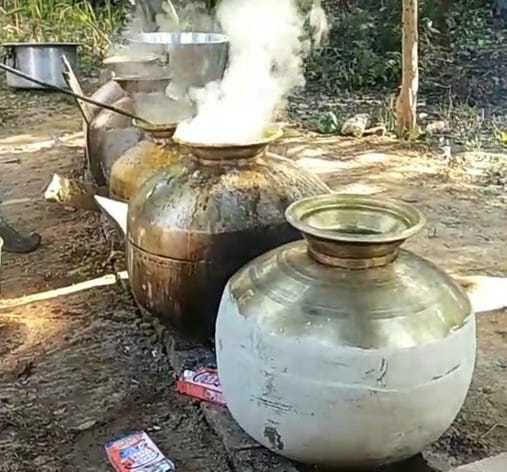Dham, a popular traditional feast prepared during marriages, local festivals, and special occasions of Chamba, Himachal Pradesh, is a complete food not only according to Ayurveda but also nutritionally. The ethnic foods, include rajmah madra, dal, kadi, khatta, rice and so forth, exhibit a treasure of food heritage and are an integral component of the diet of the people in the state. The cuisine is developed keeping in mind not only the geographical and climatic conditions of the region but also according to the traditional methods under natural conditions mostly from the staple ingredients.
History
Chamba, one of the most beautiful regions of Himachal Pradesh, was saved by the mighty Dhauladhars from the successive waves of Muhammadan invasion. Just like the plains in Kashmir, Sikandar Butshikan ruthlessly destroyed the temples built by Lalitaditya and his successors, the sacred mountains of Dhauladhars protected Hinduism and Chamba till eternity. The brazen-carved cedar wood idols of Meru Verman at the ancient shrines are the glorious testaments of the same. Thanks to the mighty snow-clad mountain barriers for even protecting the Chambyali Cuisine, which since the Vedic era has remained intact and untouched by the Islamic cuisine.
The legend has it that the kings of Chamba were the descendants of Kusha, the son of Lord Ram. It is said that Raja Meru came from Ayodhya at an early age and conquered the mountains. King Jaisthambh, one of the descendants of Raja Meru, was so bewitched by the Kashmiri foods that he wished to recreate those Kashmiri dishes in the local Chamba tradition with the complete yield of the province, to be offered to the local Goddess for her benevolence. In that period, Chamba was known for rajmah (red kidney beans), a variety of spices, and milk. The unification of the style of cooking of Chamba and Kashmir and the amalgamation of the local crops led to the creation of a novel dish madra, and hence, dham came into the fore. Madra is cooked in ghee/oil, and the uniqueness of this dish lies in its taste, wherein it is possible to perceive all the unique flavors individually, without the overwhelming flavors of onions and tomatoes.
Preparations of dham
Firewood required for cooking food is called “samdah”. The village priest suggests an auspicious date, months before dham's actual date, and all the villagers are invited on that day. Men cut the firewood, and women cook food for them while singing folk songs.
Cooking authentic chambyali cuisine is an extremely laborious and time-consuming task, which generally takes approximately 12 hours for preparation.. As dham in ancient times was offered to Gods in the temples, and owing to the caste system and some religious customs prevalent at that time, only a group of Brahmin cooks known as “botis” used to prepare the dham. For many centuries, these botis have preserved the secret recipes of the dham and have handed them to their younger generations just by word of mouth. Even now, every village has a boti of its own, who cooks authentic dishes to be served as a dham during festivals and community functions. Botis usually wear a dhoti and cook/serve the whole dham barefoot and are very strict about the hygiene and sanitation inside the kitchen, so much so that during the preparation of dham, people must enter the kitchen barefoot and have to first clean their hands, only then work is assigned to them. In ancient times, after the completion of dham, every boti was given a bagful of wheat for his services.
Dham cooking room/rasialu
The temporary kitchen is usually built outside the main house with bamboo sticks as main pillars and steel sheets as roof. The preparations for dham begin a night before when all the containers are collected from people in the village/town. In the morning, every villager brings milk and buttermilk to the temporarily created kitchen; being an agrarian society, most of them have these things in abundance at home. Many times, some vegetables such as pumpkins and so forth are also arranged within the villages, depending on the season. After finishing their work at home, all villagers come together and help botis in cutting vegetables and arranging other stuff such as spices and so forth. Almost every family in the village participates in this work.
The food is cooked in a long 6 ×2 feet trench with the help of firewood. The deep trench with fire is called “char” or “tiun” and has various other names . As already discussed, firewood used for cooking dham and dry wood are arranged a few weeks in advance. Before preparing the dham, botis worship the char/tiun and then start the cooking process. This traditional method helps in destroying the harmful germs in the surrounding area of the kitchen
Cooking and serving style
Thick copper and brass vessels called “Charoti” or “Batloi” with broad base and narrow opening are used for cooking, whereas iron cauldrons (kadhai) are used for preparing khatta. The thick base metal vessels are good conductors of heat, and their narrow shape helps in keeping the food warm for a long time. Mostly, every house in a village/town has such utensils, and they are collected 1 day before in the temporary kitchen. The food is then slowly cooked on firewood, which imparts the dham a unique flavor, and the flame from the wood kills all the possible germs
Following the Vedic traditions, the food is served in leaf plates called pattals to people sitting in painth/lines on the ground. The message of universal brotherhood is witnessed during the feast as people irrespective of their status are seated in the lines feasting from leaf plates. The plates are made of dried leaves of tour/sal or banyan trees, weaved together with thin pleats of bamboo wood and, thus, are biodegradable and environment friendly. Like the cooks, the people serve food barefoot. The food is consumed using hands, which helps the people to decide the suitable heat required for consumption. The person responsible for filling water, cleaning, and washing utensils is called panihara, and it is his duty to clean the painth area after each batch finishes partaking food.

